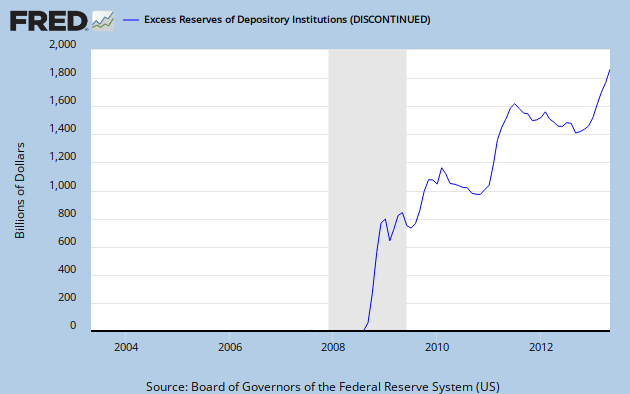As 2011 approaches, it's important to look back at the year passing. Entering 2010, analysts and experts were largely bullish on the economy and stocks. Many prognosticators expected U.S. GDP growth above 3.5%, unemployment to fall towards 9%, 10-year Treasury yields to rise above 4% and the S&P 500 to climb above 1250. Oddly enough, while the consensus was nearly dead on regarding the stock market, most other expectations for the economy proved off target. Given this divergence, considering which expectations are or aren't important for maintaining predictions on the stock market would appear to be valuable insight.
Determining the pace of economic growth for future years intuitively seems like an important factor in estimating earnings growth. (S&P 500 earnings used as metric) This intuition happens to be very misleading looking back over the past 50 years. Amazingly, since 1960 there have only been 5 years during which real GDP growth was negative over the entire year. However, during the same period, there have been 12 different years in which S&P 500 earnings declined. Of those 5 years that real GDP declined, 2008 marked only the third in which both real GDP and earnings dropped together. Also surprising, real GDP actually grew above 4% in three separate years that earnings declined. Glancing at the other 75% of the years when earnings actually grew, the level of GDP expansion shows very little correlation. GDP growth expectations may be rising toward 4%, but whether higher earnings will follow remains unclear.
With new tax cuts recently enacted and further rounds of quantitative easing (both opposites of last year's expectations), an expanding GDP is believed to start bringing down unemployment in 2011. Although pundits have predicted monthly job growth topping 250,000 since the fourth quarter of 2009 to no avail, those predictions remain widespread for 2011. As 2010 comes to a close, unemployment remains elevated near 10%. Making matters worse (in real terms, better by numbers), nearly 8 million Americans have dropped out of the workforce in the past 3 years. By comparison, when unemployment last topped 10% between 1981 and 1982, the peak to trough loss in total workforce was only 2 million. This period also began a string of negative earnings growth in 4 out of 5 years. So far, heightened unemployment has created far less damage to corporate earnings this time around. Whether this new trend holds will be interesting to watch since workforce growth alone makes hopes for 5 % unemployment daunting.
A strengthening economy was believed to generate confidence in the recovery and push investors into riskier assets in 2010. As a byproduct, Treasury yields were expected to rise with the Federal Reserve beginning to raise interest rates in the fourth quarter of the year. 10-year Treasury yields began the year above 3.8% and after briefly topping 4%, plunged below 2.35% before finishing the year around 3.4%. Rather than gaining confidence in the recovery, the Fed has actually cut economic forecasts throughout the year and embarked on a second round of quantitative easing. Although rising rates are a negative for equity valuations, yields are once again expected to rise in 2011. Yields have primarily been falling for 30 years, accompanying massive growth in earnings and stocks. If the trend reverses in coming years, this correlation may prove troublesome for bond and stock investors alike.
Heading into 2010, S&P 500 earnings were expected to increase nearly 30% to approximately $83. Despite weaker GDP growth and higher unemployment, 2010 earnings are now likely to top expectations, totaling more than $85. With that year end total, 2010 will mark the second largest increase in earnings since 1960 (when earnings were only $3.11). 2011 is thought to be another banner year for earnings, growing 14% to a new all-time high over $97. Alongside rising earnings, the S&P 500 is widely projected to increase between 10-20% next year. It's worthwhile to consider that only once since 1960 has the S&P 500 experienced double digit gains in 3 or more consecutive years (five straight from '95-'99). This amazing string was followed by the only 3 year period of recurring losses since 1960 (each year was down double digits). While the current outlook seems extremely bright, past precedent argues for caution in becoming too bullish.
As analysts, investors, economists and others share their outlooks for 2011, I urge investors to apply a couple lessons from history. First and foremost, predictions are frequently incorrect and which projections prove true is anybodies guess. Second, economic growth and unemployment may be less associated with corporate earnings or stock market performance than previously thought. Therefore, variations in economic projections or failure to accurately predict economic growth may not imply incorrect market expectations. Third, be conscious of historical trends, which may not help forecast the future but offer insight for judging projections.
For the past 6 years, strategists have predicted the S&P 500 would end the years with gains (shown above). Their predictions have proved correct 83% of the time. Unfortunately, the one year projections were wrong, the index lost nearly 40%. The S&P 500 closed 2004 at 1211.92 and today rests a few percent higher at 1257. Even more frustrating to investors, the S&P 500 closed 1998 at 1229.23. Despite rising in 10 out of 12 years, the stock market has barely moved. Predicting the stock market to rise is clearly a matter of odds. Earning returns over the long-run may prove a bit more difficult.
With only a few days left in 2010, here's to hoping the optimistic outlook for 2011 proves true.
![[b-CBOE-1115]](http://barrons.wsj.net/public/resources/images/ON-AQ741_bCBOE1_NS_20101112192651.gif)


